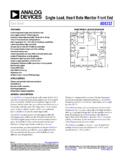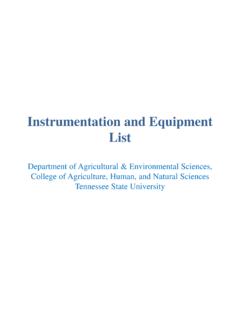Transcription of A Closer Look at State Of Charge (SOC) and State Of Health ...
1 A Closer Look at State of Charge (SOC) and State of Health (SOH) Estimation Techniques for Batteries Martin Murnane Solar PV Systems, Analog Devices, Ghazel Chief Technology Officer, EBSYS Technology GroupIntroductionBattery stacks based on lithium-ion (Li-ion) cells are used in many applications such as hybrid electric vehicles (HEV), electric vehicles (EV), storage of renewable energy for use at a later time, and energy storage on the grid for various purposes such as grid stability, peak shaving, and renewable energy time shifting. In these applications, it is important to measure the State of Charge (SOC) of the cells , which is defined as the available capacity (in Ah) and expressed as a percentage of its rated capacity. The SOC parameter can be viewed as a thermodynamic quantity enabling one to assess the potential energy of a battery.
2 It is also important to estimate the State of Health (SOH) of a battery, which represents a measure of the battery s ability to store and deliver electrical energy, compared with a new battery. Analog Devices power control processor, the ADSP-CM419, is a perfect example of a processor that has the capability to deal with battery charging techniques discussed throughout this article deals with the algorithms utilized for SOC and SOH estimation based on coulomb counting. The technical environment specifications for coulomb counting are defined and an overview of the estimation methods of the SOC and SOH parameters, in particular the coulomb counting method, the voltage method, and the Kalman filter method are presented. Several SOC and SOH estimation commercial solutions are also described. In addition, this article details the best-in-class SOC and SOH estimation algorithms, especially the enhanced coulomb counting algorithm, the universal SOC algorithm, and the extended Kalman filter algorithm.
3 Finally, the evaluation procedure and the simulation results of the chosen SOC and SOH algorithm are presented. Battery SOC Measurement PrincipleSince the determination of the SOC of a battery is a complex task depending on the battery type and on the application in which the battery is used, much development and research work has been done in recent years to improve SOC estimation accuracy. Accurate SOC estimation is one of the main tasks of battery management systems, which will help improve the system performance and reliability, and will also lengthen the lifetime of the battery. In fact, precise SOC estimation of the battery can avoid unpredicted system interruption and prevent the batteries from being over charged and over discharged, which may cause permanent damage to the internal structure of batteries. However, since battery discharge and Charge involve complex chemical and physical processes, it is not obvious to estimate the SOC accurately under various operation conditions.
4 The general approach for measuring SOC is to measure very accurately both the coulombs and current flowing in and out of the cell stack under all operating conditions, and the individual cell voltages of each cell in the stack. This data is then employed with previously loaded cell pack data for the exact cells being monitored to develop an accurate SOC estimate. The additional data required for such a calculation includes the cell temperature, whether the cell is charging or discharging when the measurements were made, the cell age, and other relevant cell data obtained from the cell manufacturer. Sometimes it is possible to get characterization data from the manufacturer of how their Li-ion cells perform under various operating conditions. Once an SOC has been determined, it is up to the system to keep the SOC updated during subsequent operation, essentially counting the coulombs that flow in and out of the cells .
5 The accuracy of this approach can be derailed by not knowing the initial SOC to an accurate enough State and by other factors, such as self discharge of the cells and leakage SpecificationsThis article encompasses the design and development of a coulomb counting evaluation platform to be used for SOC and SOH measurement for a typical energy storage module, which in this case is a 24 V module, typically comprising seven or eight Li-ion cells . The evaluation platform is composed of a hardware system including an MCU and required interfaces and peripherals, embedded software for the SOC and SOH algorithm implementation, and a PC-based application software as a user interface for system configuration, and data display and analysis. The evaluation platform periodically measures the voltage value of each cell and the battery pack s current and voltage, by means of appropriate ADCs and sensors, and will run the SOC estimation algorithm in real time.
6 This algorithm will use measured voltage and current values and some other data collected by temperature sensors, and/or given by PC-based software application (such as constructor specifications from a database). The SOC estimation algorithm output will be sent to the PC graphical user interface for dynamic display and database | Share on Twitter | Share on LinkedIn | EmailTECHNICAL ARTICLE 2 A Closer Look at State of Charge (SOC) and State of Health (SOH) Estimation Techniques for Batteries SOC and SOH Estimation Methods OverviewRegarding SOC and SOH estimation methods, three approaches are mainly being used: a coulomb counting method, voltage method, and Kalman filter method. These methods can be applied for all battery systems, especially HEV, EV, and PV, and each method is discussed in the next few Counting MethodThe coulomb counting method, also known as ampere hour counting and current integration, is the most common technique for calculating the SOC.
7 This method employs battery current readings mathematically integrated over the usage period to calculate SOC values given bySOC = SOC(t0) + (Ib Iloss) dt 1 Cratedt0 + t0 (1)where SOC(t0) is the initial SOC, Crated is the rated capacity, Ib is the battery current, and Iloss is the current consumed by the loss coulomb counting method then calculates the remaining capacity simply by accumulating the Charge transferred in or out of the battery. The accuracy of this method resorts primarily to a precise measurement of the battery current and accurate estimation of the initial SOC. With a preknown capacity, which might be memorized or initially estimated by the operating conditions, the SOC of a battery can be calculated by integrating the charging and discharging currents over the operating periods. However, the releasable Charge is always less than the stored Charge in the charging and discharging cycle.
8 In other words, there are losses during charging and discharging. These losses, in addition with the self discharging, cause accumulating errors. For more precise SOC estimation, these factors should be taken into account. In addition, the SOC should be recalibrated on a regular basis and the declination of the releasable capacity should be considered for more precise estimation. Voltage MethodThe SOC of a battery, that is, its remaining capacity, can be determined using a discharge test under controlled conditions. The voltage method converts a reading of the battery voltage to the equivalent SOC value using the known discharge curve (voltage vs. SOC) of the battery. However, the voltage is more significantly affected by the battery current due to the battery s electrochemical kinetics and temperature. It is possible to make this method more accurate by compensating the voltage reading by a correction term proportional to the battery current and by using a lookup table of the battery s pen circuit voltage (OCV) vs.
9 Temperature. The need for a stable voltage range for the batteries makes the voltage method difficult to implement. In addition, the discharge test usually includes a consecutive recharge, which makes it too time consuming to be considered for most applications. Another drawback is that during testing the system function is interrupted (offline method) contrarily to coulomb counting (online method). Kalman Filter MethodThe Kalman filter is an algorithm to estimate the inner states of any dynamic system it can also be used to estimate the SOC of a battery. Kalman filters were introduced in 1960 to provide a recursive solution to optimal linear filtering for both State observation and prediction problems. Compared to other estimation approaches, the Kalman filter automatically provides dynamic error bounds on its own State estimates. By modeling the battery system to include the wanted unknown quantities (such as SOC) in its State description, the Kalman filter estimates their values and gives error bounds on the estimates.
10 It then becomes a model-based State estimation technique that employs an error correction mechanism to provide real-time predictions of the SOC. It can be extended in order to increase the capability of real-time SOH estimation using the extended Kalman filter. Notably, the extended Kalman filter is applied when the battery system is nonlinear and a linearization step is needed. Although Kalman filtering is an online and a dynamic method, it needs a suitable model for the battery and a precise identification of its parameters. It also needs a large computing capacity and an accurate initialization. Other methods for SOC estimation are presented in various literature, such as impedance spectroscopy, which is based on cell impedance measurements, using an impedance analyzer in real time for both Charge and discharge. Although this technique can be used for Li-ion cells SOC and SOH estimation, it was omitted since it is based on external measurements utilizing instrumentation .


















